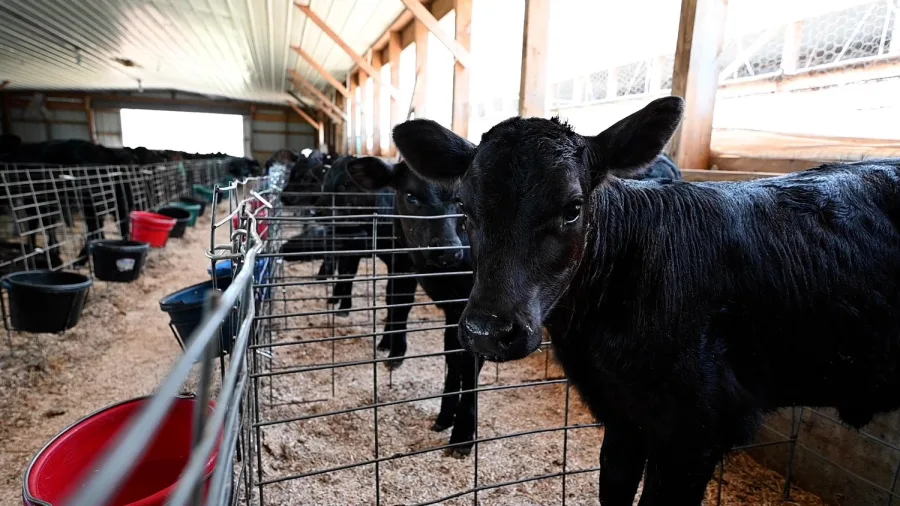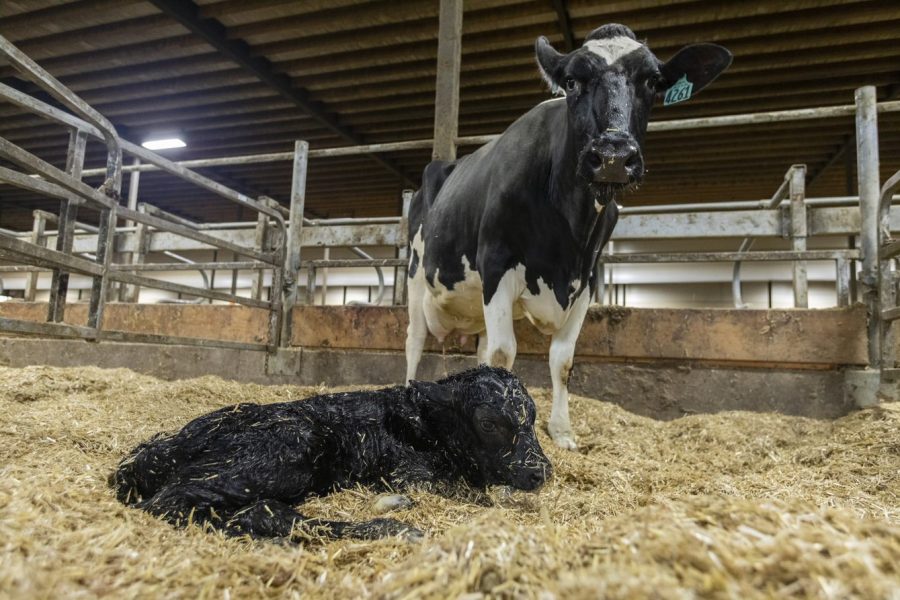Uncover the revelations on how Holstein dairy cows thrive while carrying beef crossbred calves. Is this the key to increasing farm profitability? Delve into the study’s comprehensive findings and their potential impact on modern dairy farming.

Traditionally, Holstein dairy cows have been the backbone of dairy farms nationwide. However, a new and innovative trend is emerging: crossbreeding Holsteins with beef breeds to increase herd profitability. This practice aims to combine Holstein milk production efficiency with the higher market value of beef-sired calves, presenting a unique and promising approach to dairy farming.
This approach involves Holstein cows carrying beef-sired calves, such as Angus or Limousin, producing more valuable offspring when sold. But how does this impact the health and productivity of the Holstein dams? Does carrying larger, beef-cross calves pose significant risks? Our study, with its rigorous methodology and comprehensive data collection, warrants key parameters like dystocia risk, stillbirth risk, gestation length, early lactation clinical disease events, culling risk, and subsequent milk production. Importantly, early results suggest that Holstein dairy cows are not adversely affected by producing beef crossbred calves, providing a strong foundation for a profitable shift in dairy farming practices.
Assessing the Impact of Beef Crossbred Calves on Holstein Dairy Cows: A Comprehensive Health and Productivity Analysis
A recent study meticulously examined various health and productivity metrics to explore the potential benefits and challenges of breeding Holstein dairy cows with beef sires. This comprehensive research compared outcomes between cows carrying calves sired by different beef breeds and those carrying Holstein-sired calves. Key metrics studied included dystocia risk, stillbirth rates, gestation lengths, early-lactation clinical disease events, early-lactation culling risk, and subsequent milk production. The extensive dataset covered over 75,000 lactations and nearly 40,000 cows across ten herds from 2010 to 2023. The primary objective was to assess the impact of beef crossbred calves on Holstein dairy cows. Researchers focused on whether this practice adversely affects the cows’ health and productivity, thereby influencing the profitability and sustainability of dairy farming.
Methodological Rigor Underpins Robust Findings in Dairy-Beef Crossbreeding Study
The methodology of this study was meticulously crafted to ensure robust data collection. Sourced from ten herds, the dataset spans from 2010 to 2023, offering a comprehensive view over a significant period. This approach provided 75,256 lactations from 39,249 cows, with calves sired by Holstein or various beef breeds—including Angus, Simmental, Limousin, crossbred beef, and Charolais. Wagyu sires were treated as a distinct group.
Binomial generalized mixed models assessed dystocia risk, stillbirth risk, early-lactation clinical disease events, and early culling risk. Additionally, mixed models analyzed gestation length and milk, fat, and protein yields. Only calf sire breeds with at least 150 records were included, ensuring solid statistical validity.
Evaluating Health and Productivity Metrics in Dairy-Beef Crossbreeding: A Detailed Analysis
To gauge the impact of breeding crossbred beef calves within Holstein dairy herds, the study meticulously evaluated several crucial health and productivity metrics:
Dystocia Risk: This measures the incidence of strenuous labor. The study employed binomial generalized mixed models to assess whether carrying a beef-sired calf increases dystocia risk compared to a Holstein-sired calf.
Stillbirth Risk: This evaluates the likelihood of a calf being born dead. Researchers sought to determine if beef-sired calves have a higher stillbirth risk than Holstein-sired calves, impacting farm profitability and animal welfare.
Gestation Length (GL): This refers to the duration of the pregnancy from conception to birth. The study investigated whether certain beef breeds led to longer pregnancies, affecting the cow’s health and productivity post-calving.
Early-Lactation Clinical Disease Events: The probability of clinical health issues in early lactation was examined. These events range from common conditions like mastitis to more severe problems affecting overall health and milk production.
Early-Lactation Culling Risk: This metric assesses the likelihood of cows being removed from the herd shortly after calving due to health issues or poor productivity. Understanding this is crucial for long-term herd management.
Subsequent Milk Production: The study evaluated milk, fat, and protein yields post-calving to determine if beef genetics impact a dairy cow’s primary function and profitability.
This comprehensive analysis concluded that carrying calves sired by beef breeds did not negatively affect the health and productivity of Holstein dairy cows. These insights are valuable for farmers considering dairy-beef crossbreeding to enhance herd profitability without compromising animal welfare.
Critical Insights into Stillbirth Risks and Gestation Length: Implications of Crossbreeding in Dairy Cows
Our findings revealed significant differences in stillbirth risk and gestation length between crossbred beef and Holstein bulls. Crossbred beef bulls showed a higher likelihood of stillbirth, raising questions about the underlying genetic and physiological factors. All beef-sired calves had more extended gestation periods than Holstein-sired ones, with Limousin and Wagyu-sired calves having the longest. These results highlight the need for strategic management and breeding to mitigate potential risks while leveraging the benefits of beef crossbreeding.
Groundbreaking Revelations in Dairy-Beef Crossbreeding: Holstein Dairy Cows Thrive with Beef-Sired Calves
The study’s findings showed no notable differences in dystocia risk, clinical health events, early-lactation culling risk, or milk and component yield between dairy cows carrying beef-sired versus Holstein-sired calves. This analysis suggests that integrating beef crossbreeding into dairy operations does not harm Holstein dairy cows’ health or cows’ productivity.
Strategic Beef Crossbreeding: A Pathway to Enhanced Profitability and Sustainability in Dairy Farming
The study’s findings have promising implications for dairy farmers considering beef crossbreeding. Although beef-sired calves have longer gestation periods, this does not increase the risks of dystocia, clinical health issues, or early-lactation culling, proving that Holstein cows remain healthy and productive.
The economic benefits for farmers are significant. Crossbreeding Holsteins with beef breeds like Angus and Wagyu can produce more valuable calves, enhancing profitability by diversifying income streams. Additionally, milk production and quality remain stable, allowing farmers to maintain dairy output while tapping into the lucrative beef market. This not only boosts your farm’s profitability but also contributes to the sustainability of the dairy industry, ensuring a prosperous future for dairy operations.
Using beef sires without compromising Holstein cows’ health and productivity provides a viable strategy for optimizing herd economic performance, ensuring a sustainable and prosperous future for dairy operations.
The Bottom Line
This study unequivocally demonstrates that Holstein dairy cows are not negatively impacted by producing beef crossbred calves. Regardless of the sire’s breed, dystocia risk, clinical health events, and early-lactation culling rates were consistent. While stillbirth probability and gestation length varied among beef breeds, these differences did not adversely affect the cows’ health and productivity. The findings affirm that beef crossbreeding can boost herd profitability without compromising cow welfare and productivity, offering a sustainable and profitable dairy farming practice.
Key Takeaways:
- Holstein dairy cows carrying beef-sired calves did not exhibit increased risks of dystocia, clinical health issues, or early-lactation culling compared to those carrying Holstein-sired calves.
- Crossbred beef bulls were found to have a higher probability of stillbirth than Holstein bulls.
- All beef-sired calves extended the gestation period in Holstein cows, with Limousin and Wagyu calves showing the longest gestation lengths.
- Milk production and component yields, including fat and protein, were not negatively impacted by carrying beef-sired calves.













